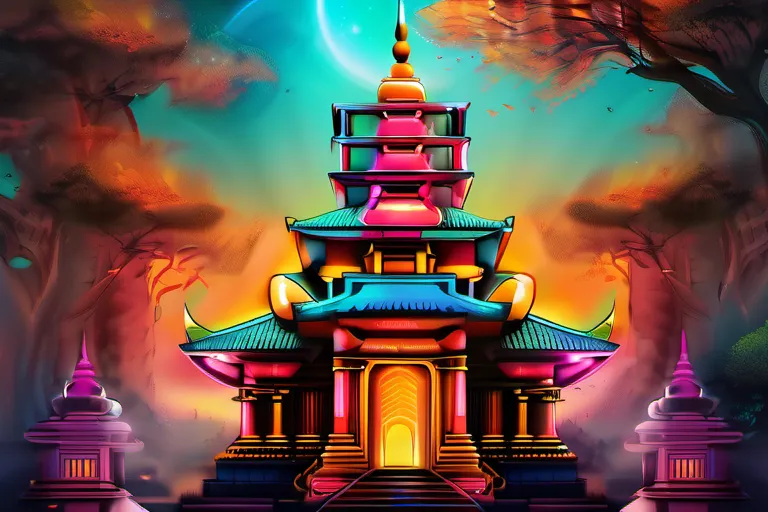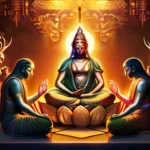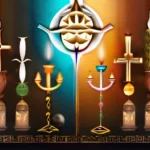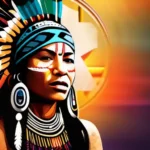Explore the origins, beliefs, and practices of polytheistic religions around the world.
Polytheism is a religious belief system that involves worshipping multiple deities or gods. This article delves into the fascinating world of polytheistic religions, their origins, beliefs, and practices across various cultures and time periods.
The Origins of Polytheism
Have you ever wondered how our ancestors viewed the world around them? The origins of polytheism offer us a fascinating glimpse into their mindset, where every aspect of nature and human experience was personified in gods and goddesses. Imagine a bustling city like Athens or Rome, with each corner housing its own deity, from the household spirits to agricultural deities and beyond. These complex networks of beliefs were not just superstitions but integral parts of daily life.
Let’s trace back to the ancient Near East. The Sumerians of Mesopotamia had a vast pantheon, including gods like Enlil (the wind god) and Inanna (goddess of love and war). Their stories and rituals were deeply intertwined with their culture, much like how the threads in a tapestry come together to form a beautiful pattern. How did these early civilizations conceptualize such complexity? Were they merely attributing human traits to natural phenomena, or was there something deeper at play?
As we move further east to India, the Hindu pantheon expands with thousands of deities, each representing different facets of life and existence. From Brahma (the creator) to Shiva (the destroyer), these figures embody various aspects of the cosmos. How did such a diverse array of beliefs evolve over time? Was it through conquests spreading one god’s dominance or through peaceful coexistence where multiple deities were honored equally?
Now, consider the Greek and Roman pantheon with its intricate family dynamics, love affairs, and conflicts. These gods and goddesses mirrored human emotions and relationships, making them relatable yet awe-inspiring figures. How did these stories shape not only religious practices but also cultural values and social structures in ancient civilizations? Were the Greeks and Romans merely expressing their fears and desires through mythological narratives?
Each civilization’s polytheistic beliefs were a reflection of its unique environment, culture, and societal needs. By understanding these origins, we can appreciate the richness and diversity of human spirituality across time and space. The evolution of these complex belief systems offers us valuable insights into our shared history and the universal quest for meaning in life.
Polytheistic Pantheons: A Closer Look
Polytheistic pantheons are like vast, colorful maps of the human imagination, each one unique and intricate. Imagine walking through a dense forest where every tree represents a deity, each branch symbolizing their role and attributes. In ancient Egypt, for instance, you’d find Ra, the sun god, towering above all others, his rays extending far beyond the sky’s canopy. But what of the gods below him? How do they interact with one another?
Consider the pantheon of Ancient Greece. Here, we have a bustling city-state with its residents constantly weaving their lives into the fabric of these deities’ stories and myths. Each god has a specific domain: Zeus controls the heavens, Athena wisdom and warfare, Apollo music and prophecy. But how do they relate? Is there tension or harmony between them?
In Hinduism, the pantheon expands to include thousands of gods and goddesses, each with distinct attributes and roles. This expansive network is often depicted as a web where all deities are interconnected, much like a vast spider’s web that supports and sustains life. Yet, in this intricate web, some gods seem more prominent than others—like Indra, the king of the gods, or Shiva, the destroyer and transformer.
Looking at Norse mythology, we find a pantheon where gods and giants often clash, representing the constant struggle between order and chaos. Here, Thor’s thunderous hammer battles against Loki’s mischievous schemes, each god embodying different aspects of nature and human experience.
Each polytheistic religion offers its own unique perspective on the world, shaping not just beliefs but also the very fabric of culture and society. These pantheons are like living ecosystems, where every deity plays a crucial role in maintaining the balance and harmony within their universe. By understanding these diverse and rich pantheons, we gain insight into the complex interplay between humans and the divine in different cultures.
Beliefs and Practices in Polytheism
Imagine stepping into a bustling marketplace where every stall tells a story, each one dedicated to a different deity. In many polytheistic religions, these deities are not just abstract concepts but tangible presences that influence daily life and natural phenomena. Let’s explore how these beliefs manifest in rituals, offerings, and festivals.
Firstly, consider the rituals that bind communities together. These practices often serve to communicate with the deities, seeking favor or warding off misfortune. For example, during harvest festivals like the Greek Dia肘nion, farmers would offer first fruits as a token of gratitude and ask for continued prosperity from Demeter and Persephone. This act is more than just symbolic—it’s a way to reaffirm one’s relationship with the divine.
The offerings made during these rituals are varied, reflecting the rich tapestry of beliefs within polytheistic traditions. In ancient Rome, worshippers would leave incense at the Temple of Vesta or sacrifice animals in the Forum to appease Juno and Mars. These acts serve as a tangible expression of devotion, grounding spiritual practices in concrete actions.
Festivals, too, hold significant importance. Think about the panathenaea in Athens, celebrating Athena’s birthday every four years. It was a grand spectacle involving parades, athletic competitions, and sacrifices to honor the goddess. These festivals create a shared experience that strengthens communal bonds and reinforces cultural identities.
The intricate web of rituals, offerings, and festivals not only sustains the relationship between humans and deities but also shapes social structures and moral codes. Each deity has its own sphere of influence, guiding human actions through both explicit commands and implicit guidance woven into daily life. By participating in these practices, individuals feel a sense of belonging to something greater than themselves—part of a vibrant ecosystem where gods and mortals coexist.
Polytheism Across Cultures
Imagine stepping into ancient Greece, where the pantheon of gods and goddesses ruled over every aspect of life. From Zeus, the king of all gods, to Athena, the patron of wisdom, each deity had a distinct personality and domain. This polytheistic world was not just a myth; it was a lived reality that shaped daily life, festivals, and even the art and architecture of the time.
How did such a complex religious system come into being? In many cultures, gods and goddesses were seen as reflections of natural forces or the personifications of abstract concepts. For example, in Norse mythology, Odin represented wisdom and sacrifice, while Thor was the protector against evil. These deities were central to the Vikings’ understanding of their world and their place within it.
Consider the pantheon as a bustling city where each god had its own temple and festival. In ancient Rome, for instance, festivals like the Lupercalia honored gods associated with fertility, while the Cerealia celebrated agriculture. These celebrations were not mere ceremonies but integral parts of social life, bringing communities together in worship and revelry.
In modern-day Africa, polytheism continues to thrive in various forms. In Nigeria’s Yoruba culture, for example, a complex network of deities and spirits governs different aspects of existence, from health and wealth to justice and protection. The belief in these Ancestors is not just spiritual but deeply woven into the fabric of community life.
How do we reconcile these vibrant polytheistic traditions with today’s dominant monotheistic religions? Are there lessons for us in understanding that our world isn’t simply divided between one god or many gods, but a spectrum of beliefs and practices?
The diversity of polytheism across cultures teaches us about the adaptability of human belief systems. Just as these gods and goddesses evolved over time to reflect changing societal needs, perhaps there is room for similar evolution in our own religious landscapes.
The Influence of Polytheism on Modern Religion
How has polytheism influenced modern religions? The answer lies deep within the historical tapestry of human spirituality, where ancient deities continue to weave their threads into contemporary beliefs and practices. Consider polytheism as a vast ocean from which many rivers of faith have flowed. These rivers include Christianity, Islam, and even some forms of Hinduism and Judaism, all of which have been shaped by the ideas and structures originally found in polytheistic systems.
Monotheistic religions often emerged in response to or through interaction with earlier polytheistic traditions. For instance, consider the Abrahamic faiths—Judaism, Christianity, and Islam—that trace their roots back to a single divine figure, yet their early scriptures are replete with stories of multiple gods and goddesses. How did these ancient deities transform into one central God? Were they simply replaced, or did they perhaps evolve in the collective consciousness?
One cannot ignore the metaphorical shadow that polytheism casts over monotheism. Just as a complex web can be unraveled to reveal simpler threads, so too can we look at modern religious texts and rituals and see echoes of their polytheistic origins. The concept of polytheism challenges us to question the absolute nature of belief in one God, encouraging a more nuanced understanding of spiritual diversity.
In contemporary spirituality, the influence of polytheism is evident in the resurgence of pantheons and mythological figures from various cultures. Modern pagans and neo-pagans often draw on ancient deities, reinterpreting them for today’s contexts. This revival raises questions about the nature of tradition versus innovation in religious practice. Are we simply revisiting old ideas or creating something entirely new?
As we explore these concepts, it becomes clear that polytheism has not just influenced religion but also shaped our understanding of the divine and the world itself. It invites us to think beyond monotheistic boundaries, fostering a more inclusive and multifaceted approach to spirituality.
Polytheism in the Modern World
As we journey into the modern world, you might wonder: how do ancient polytheistic beliefs and practices continue to influence contemporary society? In many ways, these religions are not just relics of history but living traditions that are being revived, reinterpreted, and adapted in the present day.
Consider the vibrant festivals and cultural events that celebrate gods and goddesses around the world. These celebrations are more than mere recreations; they are profound expressions of identity and heritage. For instance, the Día de los Muertos (Day of the Dead) in Mexico is a polytheistic celebration honoring deceased loved ones, blending indigenous Aztec rituals with Catholic influences.
Moreover, contemporary artists and writers often draw inspiration from polytheism to explore complex themes. Authors like J.R.R. Tolkien have woven intricate pantheons into their mythologies, creating realms where multiple deities interact and influence the narrative. This blend of old and new is a testament to the enduring appeal of polytheistic stories.
Another fascinating aspect is the way in which polytheism is being integrated into modern spirituality. Many find solace in the diverse pantheon of deities, each representing different aspects of life or nature. In this context, polytheism becomes a form of psychological therapy, offering individuals multiple pathways to divine connection and personal growth.
Furthermore, polytheistic practices are gaining traction among those seeking a more holistic approach to religion. The idea that the divine is multifaceted rather than singular resonates with many, providing a sense of community and belonging through shared worship and rituals. This revival can be seen in various neo-pagan movements that embrace ancient traditions while adapting them for contemporary contexts.
So, as we explore these modern interpretations of polytheism, we are not merely looking back at history but delving into the dynamic interplay between tradition and innovation. It is a journey where old gods come alive once more, breathing new life into our understanding of spirituality and community.
Conclusion
 By understanding the complexities and nuances of polytheistic religions, we gain a deeper appreciation for the richness and diversity of human spirituality throughout history.
By understanding the complexities and nuances of polytheistic religions, we gain a deeper appreciation for the richness and diversity of human spirituality throughout history.











